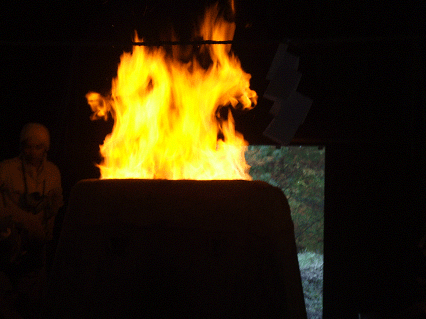
Tatara ![]() Intro-San-inへ戻る
Intro-San-inへ戻る

Furnace at work during Tatara
Tatara
‘Tatara ‘ is a traditional method of steel manufacturing,
the term
originally meaning ‘a bellow’. You have only a very limited number of occasions
in a year to be able to watch the actual
operation. The author is grateful to
Mr. Kageyama of The Network for History and Culture in
Shimane, ‘Mokumoku’,
for giving us a chance to participate in
the tour. The operation continues for three
days and nights without intermission, during
which ‘Murage ‘, the project leader,
has to watch the color of the flame in the
furnace and adjust the amount of charcoal
and iron sand to be added accordingly. It is said, the color should be that of the
rising
sun for the first day, that of the glaring
sun of the midday in the second day, and
that
of the sun set for the third day.
Murage
The Murage we saw was a woman. This would never have happened
in old days. The god of metals was believed to be a woman,
very envious, and no
woman was allowed in the furnace area. The workers were all men and their wives
could not wear any makeup during the operation
so as not to incur jealousy of the
goddess. We visited the venue in the morning of the
third day of operation, when
the operation was coming to a completion. The Murage, dog-tired after a hard work
of three days and nights, with her face stained
with charcoal, looked very satisfied
with the accomplishment. She was giving orders to about ten of young
workers.
Her eyes were as vivid and fresh as the chilly
air in the morning in this mountainous
area. I was reminded of the old days when I used
to do experiments for a few days
without sleep, tired but excited with the
accomplishment.
This project, however, is not for the purpose
of steel manufacturing.
It does not pay. This is for the purpose of education and
exhibition. The trainees
are college students and staff members working
for some metals companies who
want to know the principle of steel manufacturing. The place we visitied was in
Yoshida Town in Shimane Prefecture, a beautiful mountainous place
at about
2 hours' drive from Matsue.
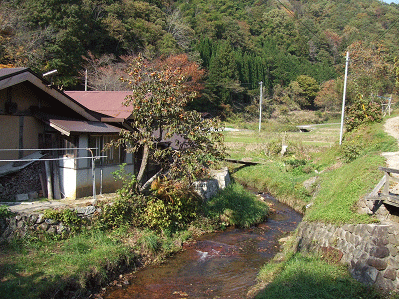
Riverbed stained brown
This used to
be one of the base places for steel making.
The riverbed, even
now, is stained brown due to iron dust. A
comprehensive literature is given in
the home page by Hitachi Metals, Ltd.,
(http://www.hitachi-metals.co.jp/e/tatara/
)
so only a brief summary is given here concerning
Tatara.
Modern Tatara
Tatara which was demonstrated here is modern Tatara. Ancient Tatara
dates back to more than 1000 years ago. This
steel making technology is believed
to have come from some ancient Asian country,
probalby India. It was improved
and refined around this area, where wood
was abundant for charcoal and good
quality iron sand was available. Actually
two kinds of iron sand are necessary,
'Masa iron sand' and 'Akome iron sand'. The mixing ratio of them influences
the
characteristics of the produced steel.
Furnace is a vagina
The
furnace is compared to the vagina in which
steel is given life.
(That's why it is Goddess rather than God
who takes care of metals). The kind
of iron sand which is easily reduced and
put into the furnace at the beginning
is called 'komori 'iron sand meaning 'nurse' iron sand, which
is helpful in every
way in producing steel from other kinds of
iron sand. The best part of produced
steel is called 'Tamahagane' and its quality is on the world top level,
and used
for such sharp edges as Japanese swords.
The furnace is built from soil. During
Tatara, the soil wall of the furnace is eaten up
gradually in the process of reduction
and becomes so thin that it can barely sustain
itself at the end of the last day.
So, it can easily be broken to take out the
contents, starting from the top.
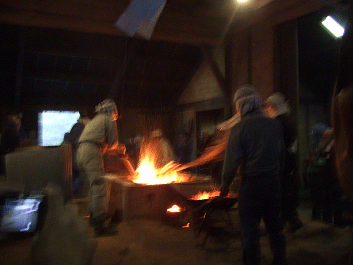
The contents are carried out for inspection
with a singly-wheeled carrier.
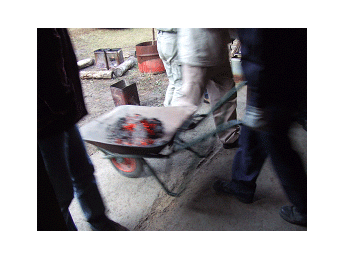
The big residual contains such valuable metals
as Tamahagane.
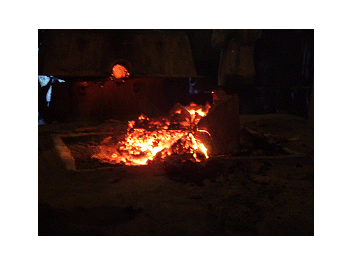
End of operation
Thus, the soil plays a big role in the chemical
reaction. We can easily
understand its importance. But it is rather
hard to imagine the role of
another important element, the wind.
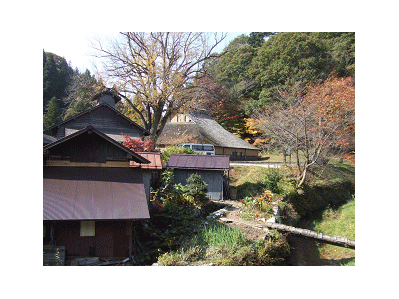
The venue of tatara operation
The big house in the middle of
the photo above indicates the location
of a furnace. This place was chosen because
the winds from three
directions meet there, we learned. But the
most important element is,
of course, the know-how of Murage. He inherited it from his father,
who also inherited from the grandfather,
and so on. Murage's responsibility
was very heavy, but he occupied the best
place in residence, and earned
the highest wages.